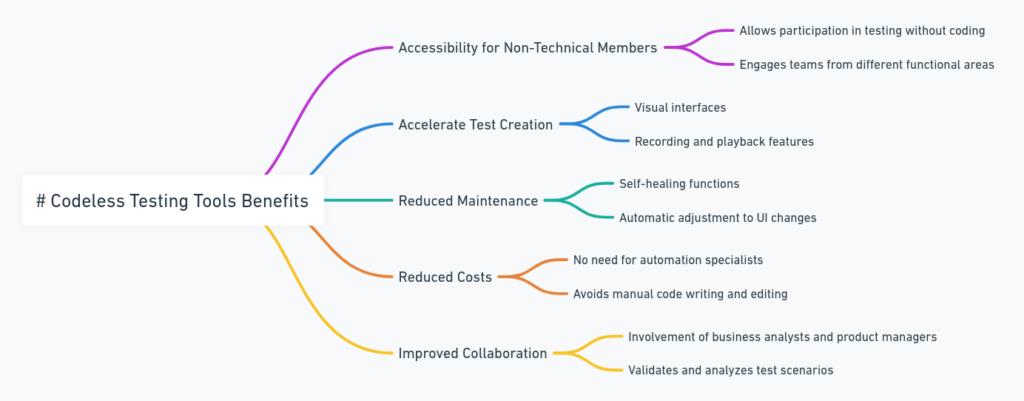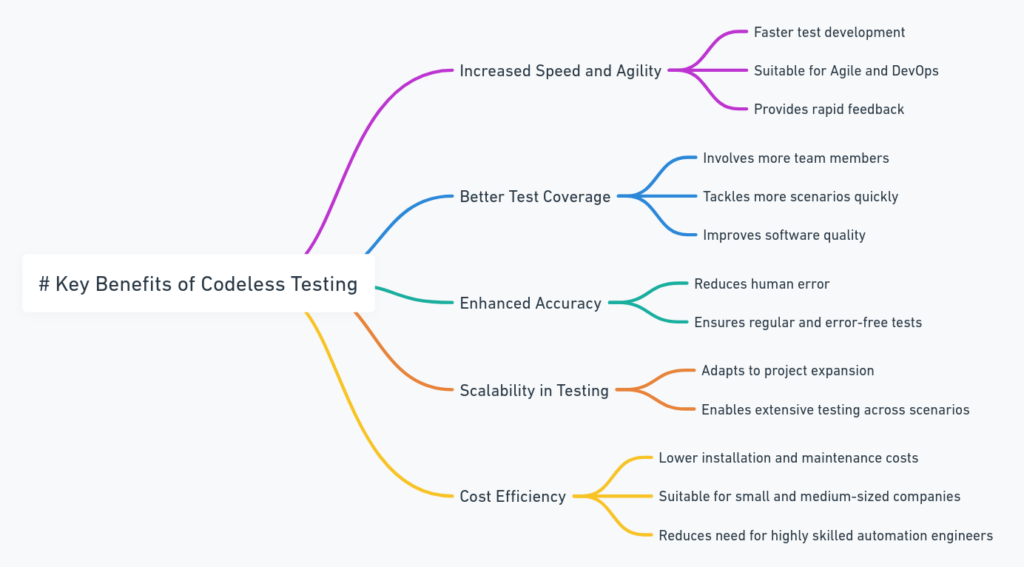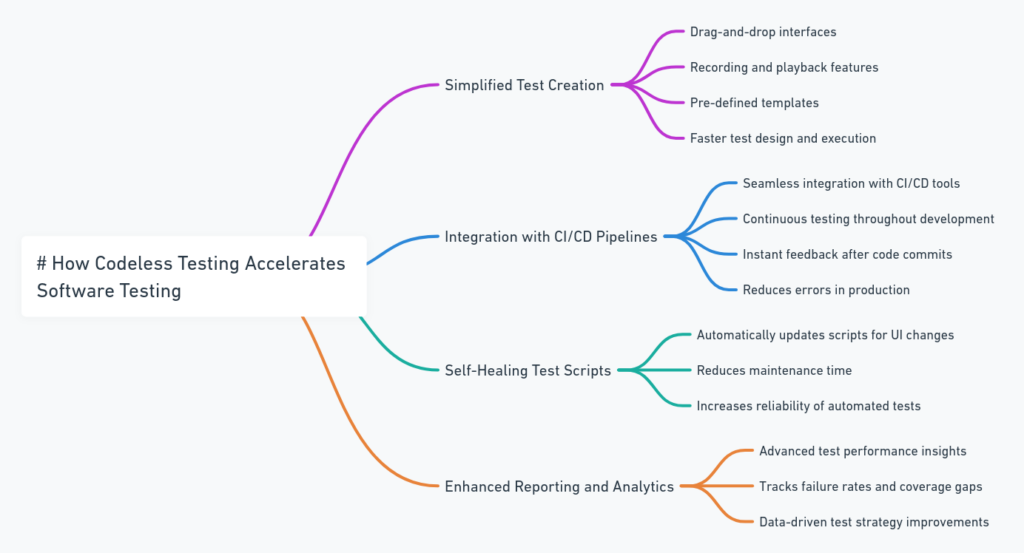Codeless Testing Tools are gaining traction as game changers in automation of tests, giving testers without the need for deep knowledge of programming.
These tools enable non-technical members of the team to be directly involved in automation and speed testing and improving the overall quality of software.
This article will look at the new trend of automated testing that is code-free as well as its benefits as well as the most widely used tools and how they are redefining software testing for companies that are of any size.
What is Codeless Testing?
Tests that are codeless, just as its name implies is a test method that doesn't require the writing of code to design and implement automated tests.
Instead, it makes use of user-friendly interfaces, such as drag-and-drop capabilities, recording and playback features as well as visual workflows for building tests.
The main purpose of testing with codeless is to make automated testing available to a greater number of users, which includes manually testing, business analysts and team members who do not have a coding background.
As the popularity in Agile and DevOps methods and tools for testing with codeless technology, they allow quicker testing and test execution, helping teams complete rapid and high-quality releases.
Why Codeless Testing Tools are Gaining Popularity

Testing tools that are codeless are becoming popular because of the following benefits:
Accessibility for non-technical team Members
With tools that do not require code anyone can build automated tests, making it easier to participate in the process of testing. This enables teams from different functional areas to be active participants with the quality control (QA) method.
Accelerate Test creation
Codeless tools accelerate the test creation process by allowing testers to create tests quickly using visual interfaces, or recording and playback functions. This rapid advancement makes it easier to create automated tests.
Reduced maintenance
Certain tools that are code-free have self-healing functions that automatically adjust tests whenever there is a change in the User Interface (UI) or functions which reduces the requirement for ongoing testing.
Reduced costs
With the use of codeless testing, businesses cut costs associated with hiring specialists in automation and can avoid the long procedure of editing and writing code thus reducing the cost of testing overall.
Improved Collaboration
Team members who are not technical like business analysts and product managers can utilize software that does not require code to analyze and validate test scenarios and improve the collaboration among teams.
Key Benefits of Codeless Testing in Software Development

The use of tools for testing that are codeless has many benefits, including:
1. Increased Speed and Agility
Codeless tools facilitate faster testing, allowing testers to develop tests with no code. This is a good fit to Agile as well as DevOps environments where frequently released software and short development times are common.
Tools that are codeless allow testing to keep up with rapid development, providing rapid feedback and faster time-to-market.
2. Better Test Coverage
By together tools for testing without code team members can tackle more scenarios in a shorter time. Through reducing the complexity of testing and allowing more team members to be involved in the creation of tests, which improves overall test coverage, which results in better software quality.
3. Enhanced Accuracy
Tests that are codeless reduce the chance of errors made by humans, especially in repetitive tasks. Through with automatized workflows, templates and processes tools that are codeless warrant the tests get conducted regularly and without mistakes made by hand, thereby increasing the reliability.
4. Scalability in Testing
As projects expand and the scope of work expands, so will the requirement for extensive testing. Tools for testing without code allow for easier scaling automated testing, allowing teams to design more tests in a variety of scenarios and environments, without requiring more programming resources.
5. Cost Efficiency
With lower costs for installation, maintenance, and staff, codeless testing is more affordable than traditional methods of automation. It allows small and medium-sized companies to automatize testing without the expense of highly skilled automated engineers.
Popular Codeless Testing Tools
Here's a look into some popular tools for testing without code that have earned recognition for their simplicity of use as well as their versatility and ability to work with the latest development environments:
1. ContextQA
ContextQA is a no-code test automation platform that enhances the engineering team’s productivity by automating complex QA tasks, reducing regression cycles, and minimizing the cost and effort required to maintain high software quality standards.
Key Features:
- AI-Powered Bug Detection and Analysis
- Comprehensive Knowledge Graph
- True No-Code Automation
- AI-Driven Visual Regression Testing
- Comprehensive errors, logs and traces
Benefits:
- Save costs on automation code creation and maintenance
- Clear JIRA backlog in days, and not months
- Prioritize critical flows automatically and save execution efforts
- Increase user satisfaction with better-focused coverage
2. Testim
Testim utilizes AI to help speed up the development as well as maintenance for automated test. It has a drag-and drop interface for testing with ease and self-healing features powered by AI to assure tests remain operational even after updates to the application are made.
Testim is renowned for its capacity to handle complicated UI components, which makes it ideal for dynamic apps.
3. Ranorex Studio
Ranorex Studio is a powerful software for testing without code that can be used on desktop as well as mobile applications. It provides playback and record capabilities and test cases that are customizable as well as an adaptable test suite.
Ranorex Studio is known for its extensive reporting capabilities which makes the software appropriate for teams that need thorough analysis of the test payoff.
4. Leapwork
Leapwork is a user-friendly flowchart-based interface which allows testers to visualize tests without having to write any code. It works with desktop, web and SAP applications, and is integrated into workflows for CI/CD.
Leapwork's intuitive approach to automation makes it easier for non-technical users. This allows teams to increase the scale of testing easily.
How Codeless Testing Accelerates the Software Testing Process

1. Simplified Test Creation
Testing tools that use drag-and-drop interfaces, recording and playback features and templates pre-defined to permit testers to build tests in a short time.
This makes it easier for QA teams to run tests at a faster speed, which reduces the time required to design and test within production settings.
2. Integration with CI/CD Pipelines
Many codeless testing software tools integrate effortlessly with pipelines for CI/CD which allows ongoing testing through the entire development cycle.
This integration makes sure that automated tests are running after every commit to code, giving instant feedback to developers as well as reduces the chance of errors that make it to production.
3. Self-Healing Test Scripts
One of the major issues in testing automation is keeping scripts up-to-date, particularly when the interface of an application is constantly changing.
Numerous codeless tools today have self-healing functions that adjust elements and locators to adapt to small UI modifications. This helps reduce time spent on maintenance of scripts and increases the reliability testing with automated tools.
4. Enhanced Reporting and Analytics
Test tools for codeless often have advanced analytics and reporting features which bring information about the performance of tests as well as failure rates and gaps in coverage.
These insights assist teams in making decision-based on data to improve test strategies as well as boost the quality of their applications.
The Future of Codeless Testing in Automation
The use of codeless tests is changing automation of tests through making it more accessible speedier, more efficient, and faster.
With AI and ML technology improve and become more advanced, we can expect more advanced features from software that is code-free, like better testing, predictive analytics and improved self-healing mechanisms.
This is a great opportunity to QA teams to adopt more agile methods, and release top-quality software quicker and more economically.
Testing with codeless is likely to keep growing particularly when it comes to Agile as well as DevOps environments where speed and flexibility are crucial.
While some scenarios might still require coding-based automation but codeless tools are becoming adept at taking care of all test scenarios and empowering teams to increase their automation efforts with less the complexity.
Book a Demo and experience ContextQA platform in action with a complimentary, no-obligation session tailored to your business needs.
Conclusion:
The move to software for testing that is code-free marks the beginning of a new age in automated testing, which is making the process more accessible and allows more members of the team to be involved in quality assurance.
Through reducing the time spent creating tests by reducing maintenance requirements and integrating with workflows for CI/CD Codeless testing speeds up the entire process of testing which means faster release times and more reliable software.
As more companies adopt software for testing that is codeless and techniques, they will be better equipped to handle testing in complicated rapid-paced development environments.
With the capability to release high-quality software faster and effectively and efficiently, codeless testing is set to become an integral part for modern software development.
Which will transform the way teams approach automation and quality assurance.
Also Read - Conducting Impact Analysis: A Crucial Step in Testing
